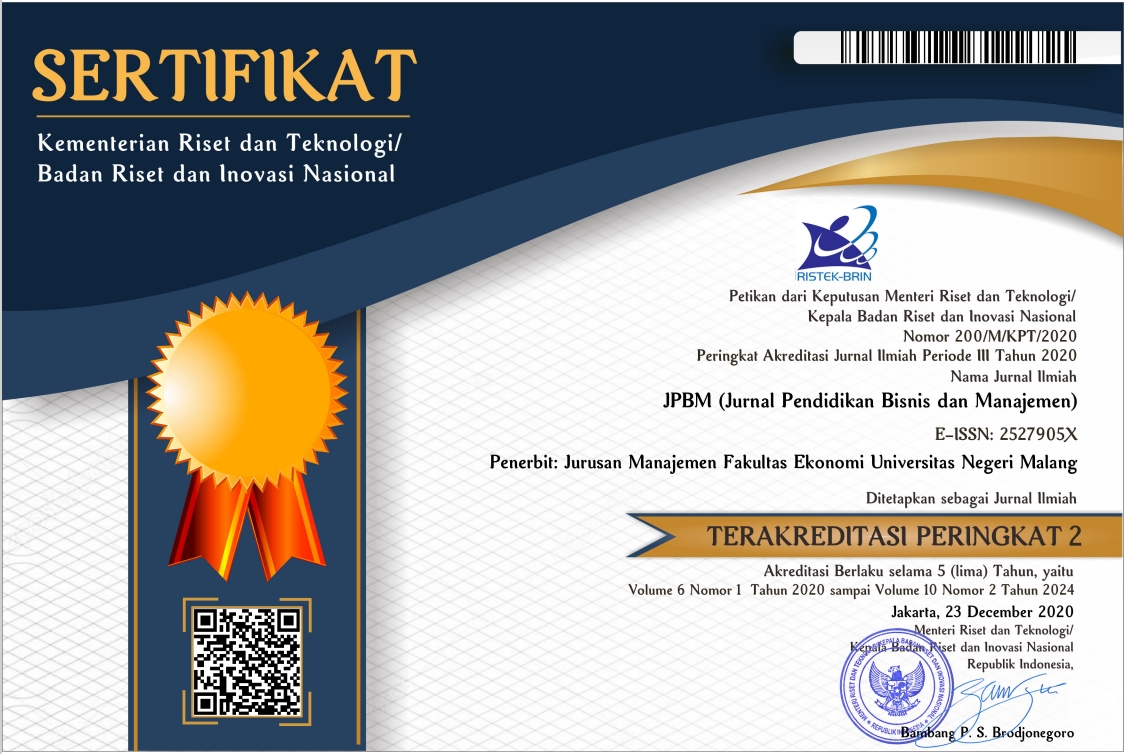The Effect of Social Media Activities on Purchase Intention Study on Somethinc, A Local Skincare Brand in Indonesia
Abstract
The sales of the skincare industry in Indonesia increase from year to year. Along with the increase in social media use, it results in newcomers in the local brand sector; one is a brand called Somethinc. This study analyses social media activities (SMA) regarding purchase intention over a local skincare brand in Indonesia. This research was built using quantitative cross-sectional sampling with a total of 258 samples who lived in Jabodetabek. They are following Somethinc on social media, especially its Instagram @somethincofficial, yet they have never purchased Somethinc products. The data were analyzed using the SEM method through the SmartPLS 3.2.9 application. The results show that SMA has direct influences on brand equity, and brand equity influences purchase intention. Moreover, SMA also has a direct effect on purchase intention. This study proves that social media activities (SMA) significantly increase brand awareness, brand image, and purchase intention. The presence of customization, interactions, eWOM, and trendiness further enhance the positive effect. This means that managers must provide the latest and relevant information about their products in all cases.
Keywords: Social media activities, Brand equity, Purchase intention, Instagram, Local brand, Skincare
Full Text:
PDFReferences
Aaker, D. A. (1996). Measuring brand equity across products and markets. California Management Review, 38(3), 21–43.
As’ad, H.A.-R. (2014). The impact of social media marketing on brand equity: An empirical study on mobile service providers in Jordan. Review of Integrative Business & Amp; Economics Research, 3(1), 1–17.
Ashley, C., & Tuten, T. (2015). Creative strategies in social media marketing: An exploratory study of branded social content and consumer engagement. Psychology & Marketing, 32(1), 15–27.
Bian, X., & Moutinho, L. (2011). The role of brand image, product involvement, and knowledge in explaining consumer purchase behaviour of counterfeits: Direct and indirect effects. European Journal of Marketing, 45(1/2), 191–216.
Bilgin, Y. (2018). The effect of social media marketing activities on brand awareness, brand image and brand loyalty. Business & Management Studies: An International Journal, 6(1), 128–148.
Bowen, G., & Bowen, R. (2015). Offline and online brand trust models: their relevance to social media. Journal of Business and Economics, 6(1), 102–112.
Chan, N. L., & Guillet, B. D. (2011). Investigation of social media marketing: how does the hotel industry in Hong Kong perform in marketing on social media websites? Journal of Travel & Tourism Marketing, 28(4), 345–368.
Charo, N., Sharma, P., Shaikh, S., Haseeb, A., & Sufya, M. Z. (2015). Determining the impact of ewom on brand image and purchase intention through adoption of online opinions. International Journal of Humanities and Management Sciences, 3(1), 41–46.
del Barrio-García, S., & Prados-Peña, M. B. (2019). Do brand authenticity and brand credibility facilitate brand equity? The case of heritage destination brand extension. Journal of Destination Marketing & Management, 13, 10–23.
Dessart, L., Veloutsou, C., & Morgan-Thomas, A. (2015). Consumer engagement in online brand communities: a social media perspective. Journal of Product & Brand Management, 24(1), 28–42.
Erkan, I., & Evans, C. (2018). Social media or shopping websites? The influence of eWOM on consumers’ online purchase intentions. Journal of Marketing Communications, 24(6), 617–632.
Ershad, Z. S., & Aghajani, T. (2017). Prediction of Instagram social network addiction based on the personality, alexithymia and attachment Styles. Sociological Studies of Youth, 8(26), 21–34.
Fischer, E., & Reuber, A. R. (2011). Social interaction via new social media:(How) can interactions on Twitter affect effectual thinking and behavior? Journal of Business Venturing, 26(1), 1–18.
Godey, B., Manthiou, A., Pederzoli, D., Rokka, J., Aiello, G., Donvito, R., & Singh, R. (2016). Social media marketing efforts of luxury brands: Influence on brand equity and consumer behavior. Journal of Business Research, 69(12), 5833–5841.
Hajli, N. (2015). Social commerce constructs and consumer’s intention to buy. International Journal of Information Management, 35(2), 183–191.
Hasibuan, L. (2022). Industri kecantikan tahan krisis, laris manis meski pandemi. https://www.cnbcindonesia.com/lifestyle/20221104104902-33-385138/industri-kecantikan-tahan-krisis-laris-manis-meski-pandemi
Hsieh, A., & Li, C. (2008). The moderating effect of brand image on public relations perception and customer loyalty. Marketing Intelligence & Planning, 26(1), 26–42.
Indonesia, D. (2012). Indonesia miliki 97,38 juta pengguna instagram pada Oktober 2022, Dataindonesia.id. Retrieved from https://dataindonesia.id
Jayani, D. H. (2021). Proporsi populasi generasi Z dan milenial terbesar di Indonesia. https://databoks.katadata.co.id/datapublish/2021/05/24/proporsi-populasi-generasi-z-dan-milenial-terbesar-di-indonesia
Kang, M. J. (2005). A study on the effect of features of brand community using one-person media on consumers. Seoul: Seoul National University.
Keller, K. L. (2009). Building strong brands in a modern marketing communications environment. Journal of Marketing Communications, 15(2–3), 139–155.
Kemp, S. (2022) Digital 2022: Indonesia - DataReportal – global digital insights, DataReportal. Retrieved from https://datareportal.com/
Kim, Angella J, & Ko, E. (2012). Do social media marketing activities enhance customer equity? An empirical study of luxury fashion brand. Journal of Business Research, 65(10), 1480–1486.
Langaro, D., Rita, P., & de Fátima Salgueiro, M. (2018). Do social networking sites contribute for building brands? Evaluating the impact of users’ participation on brand awareness and brand attitude. J. Mark. Commun, 24, 146–168.
Majeed, M., Owusu-Ansah, M., & Ashmond, A.-A. (2021). The influence of social media on purchase intention: The mediating role of brand equity. Cogent Business & Management, 8(1), 1944008.
Martin, K., & Todorov, I. (2010). How will digital platforms be harnessed in 2010, and how will they change the way people interact with brands? Journal of Interactive Advertising, 10(2), 61–66.
Masa’deh, R., AL-Haddad, S., Al Abed, D., Khalil, H., AlMomani, L., & Khirfan, T. (2021). The impact of social media activities on brand equity. Information, 12(11), 477.
Schroeder, W. K. (2017). Leveraging social media in# familynursing practice. Journal of Family Nursing, 23(1), 55–72.
Sulthana, A. N., & Vasantha, S. (2019). Influence of electronic word of mouth eWOM on purchase intention. International Journal of Scientific & Technology Research, 8(10), 1–5.
Teng, L., Laroche, M., & Zhu, H. (2007). The effects of multiple‐ads and multiple‐brands on consumer attitude and purchase behavior. Journal of Consumer Marketing, 24(1), 27–35.
Treitel, Y. (2020). The impact of Instagram usage and other social factors on self-esteem scores. Walden University.
Vukasovic, T. (2013). Building successful brand by using social networking media. Journal of Media and Communication Studies, 5(6), 56.
Zeng, F., Huang, L., & Dou, W. (2009). Social factors in user perceptions and responses to advertising in online social networking communities. Journal of Interactive Advertising, 10(1), 1–13.
Zhu, Y.-Q., & Chen, H.-G. (2015). Social media and human need satisfaction: Implications for social media marketing. Business Horizons, 58(3), 335–345.
DOI: http://dx.doi.org/10.17977/um003v9i32023p251
Refbacks
- There are currently no refbacks.
JPBM (Jurnal Pendidikan dan Bisnis Manajemen) is licensed under a Creative Commons Attribution-NonCommercial-ShareAlike 4.0 International License.
JPBM (Jurnal Pendidikan dan Bisnis Manajemen) is abstracted and indexed in :
















